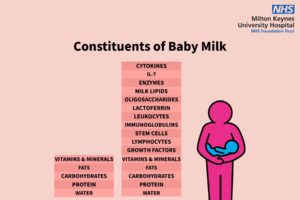Baby Milk Constituents

The image above lists the key ways in which the constituents of breastmilk or human milk work to protect infant health.
Key points
- Even the basic nutritional constituents vary greatly between human milk and infant formula. Breastmilk contains many more live constituents that promote health.
- Water: We are very lucky to have access to clean water in UK, but occasionally climate issues like floods, accidental over use of cleansing products, or fluorine can sometimes contain contaminants. Breastmilk water is filtered at source.
- Protein: Protein in breastmilk is more whey based (60-80%) and easier to digest and the main protein, alpha lactalbumin, which makes up 20% of the total protein, has been associated with the destruction of over 40 types of cancer cells including bladder and brain. Protein in formula (cows’ milk protein) has been associated with an increased risk of a baby developing juvenile onset diabetes.
- Carbohydrates: Lactose is the primary carbohydrate in breastmilk and provides around 40% of the total calories. Lactose is also more prevalent in UK formula but you may also see sucrose, fructose and glucose in some soya or lactose free formula.
- Fats are essential for brain development and absorption of fat soluble vitamins, and are a major calorie source. The long chain polyunsaturated fatty acids (LCPs) which naturally occur in breastmilk support the development of the entire nervous system including retinol development (improved eyesight) and there is some evidence of a link to improved IQ. Fats in formula tend to change depending on the market – currently they are mainly vegetable such as rapeseed oil, sunflower oil, coconut oil and algal oil, but some contain egg (egg phospholipid anhydrous milk fat) or fish oil.
- Vitamins and minerals are essential for the health of our bodies from healing wounds and supporting bone growth to bolstering the immune system. In formula milk extra vitamins and minerals are added to the powder to ensure they are sustained for the entire shelf life (six months to a year), so amounts will vary accordingly.
- Growth factors: Epidermal, insulin and transforming factors which promote gut growth. The epidermal growth factor is higher in the milk of mothers who have preterm babies, and it is linked to a reduction in Necrotising Enterocolitis (NEC) and other inflammatory responses. There is some evidence that growth factors also play a role in early life programming and so may be associated with a reduced risk of obesity and cancer in later life.
- Transfer factors enable effective absorption of nutrients in the milk e.g. lactoferrin, which assists with the absorption of iron, and in so doing reduces the amount of free iron which attracts bacteria. Lactoferrin is also bactericidal e.g. it kills E.coli bacteria. There are also transfer factors that help with the absorption of fats and vitamins.
- Stem cells: an internal repair system – these cells have the ability to develop into many different cell types. There is some evidence that these cells remain in the system long after breastfeeding has stopped. Scientists are looking at their potential for treating conditions such as leukaemia, diabetes, spinal injuries and Parkinson’s.
- Immunoglobulins: IgA, IgG, IgM and IgD, the most important is IgA, which provides a protective coating to the baby’s gut; it covers the mucosal gut surface to prevent entry of pathogenic bacteria and enteroviruses (E Coli, Salmonella, Streptococci, Staph, pneumococci, rotavirus etc.), protecting against gastroenteritis, respiratory infections etc. Please see slide 11 for an explanation of how a mother provides up to date antibodies to her baby.
- Leukocytes destroy harmful bacteria. One type, called macrophages, also produce lysozyme, an enzyme which destroys bacteria by disrupting the cell wall.
- Oligosaccharides: More than 200 types of simple carbohydrates are found in breastmilk. These influence the development of the microflora by increasing the number of beneficial bacteria found in the baby’s gut and in so doing they protect the baby against infections e.g. otitis media, respiratory, urine and gastrointestinal.
- Milk lipids damage the outer surface of certain virus types, reducing infection rate in the baby.
- Enzymes aid digestion and absorption and some destroy bacteria.
- IL-7 is linked to the size of the thymus which is a central organ in the immune system. Breastfed babies have a much larger thymus than formula fed babies, which demonstrates a stronger immune system. IL-7 also has a role in stimulating antibody producing cells. It is also considered to play a part in reducing the risk of childhood leukaemia.
- Cytokines: Another important constituent for boosting immune system.
Last Modified: 3:56pm 20/09/2021
For all media enquiries please contact [email protected]
